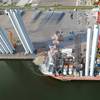A fleet of passenger/vehicle ferries fuelled with liquefied natural gas (LNG) is to be built to serve two important link routes on the Norwegian coast. Bergen lean-burn spark ignition gas engine generator sets from Rolls-Royce have been selected as prime movers for all five 129m long ferries, in a gas/electric propulsion system
Three of the double-ended vessels will shuttle between Halhjem and Sandvikvåg, joining sections of the E39 highway along the coast south of Bergen, the other two between Arsvågen and Mortavika in the Stavanger region. These routes are the second and third most intensively used ferry links in Norway in terms of passenger and vehicle numbers. The vessels are to be built at Aker Yards for Fjord 1, and are scheduled to go into operation at the beginning of 2007.
The ferries are an important element in Norway’s plan to introduce a natural gas distribution infrastructure, which should reduce pollution by replacing some consumption of heavier hydrocarbons with cleaner-burning gas. Despite its position as a major producer and exporter of natural gas, the country currently has a very limited internal distribution network and ferries operating intensively on fixed routes will be among the key consumers in the future.
All five ferries will carry a mix of vehicles within a 198 car-equivalent limit, and up to 530 passengers, but will be powered for different service speeds. Three of them are to have a total of 12,370kW of engine power, provided by two Bergen KVGS-16G4 engines each of 3,535kW and two KVGS-12G4 units each rated at 2,650kW, to give a service speed of 21 knots. Only 17knots is required of the other pair of ferries on the Arsvågen-Mortavika route, so they will be equipped with just two of the same model of 12-cylinder engines.
Bergen gas engines are well-proven as prime movers for generator drive. The K-G4 version for genset applications was introduced in 2002. Last year this engine series was launched as a variable speed engine for marine propulsion using direct mechanical transmission, which opens up a broader field of application as the use of gas-fuelled vessels develops over the course of the next few years.
K-G4 has a bore of 250mm and a 300mm stroke, producing 200kW per cylinder at 600-1,000rpm. Configurations of 6, 8 or 9 cylinders in line , and V-12, V-16 and V-18 are available, giving a power range of 1,200 to 3,600kW at the flywheel. The efficiency is 44% under ISO conditions, thanks to the advanced lean-burn technology. When burning natural gas, CO2 emission per kilowatt-hour is about 25% lower than a comparable diesel engine, NOx emissions are very low and there is no release of particulates or SOx.
Altogether over 350 Bergen gas engines have been produced since the first commercial unit went into service in1991, development of the lean-burn technology having started in 1984. Until now, all have been applied to land electric power generation. But many of the installations are multi-engine self-contained power stations for industrial plants, the operating profiles and load patterns of which have many similarities with gas-electric marine installations using constant-frequency generator sets. Individual Bergen gas engines have now exceeded 90,000 running hours and cumulative hours are over 10 million.
Featured videos

Inmarsat Enhances Service to Drive Digitalization

Inside the Electrified Truckable Tug

Tracking Foreign Vessels Working in the U.S. Jones Act Market
Subscribe for
Maritime Reporter E-News
Maritime Reporter E-News is the maritime industry's largest circulation and most authoritative ENews Service, delivered to your Email five times per week









